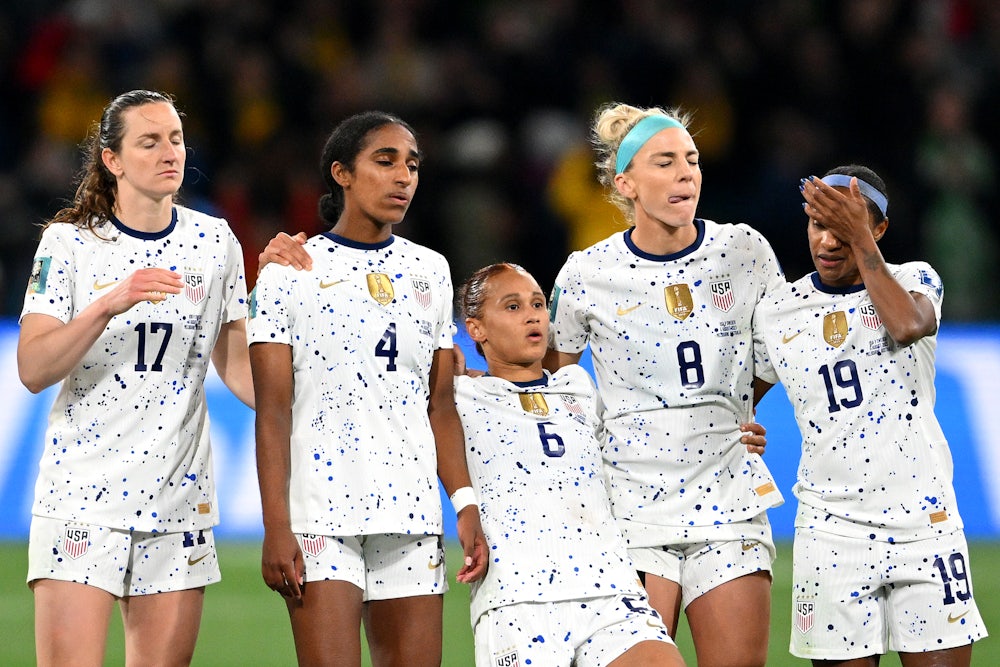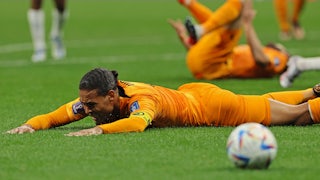Sometimes the ball doesn’t go in the net. Sometimes it almost crosses the goal line but doesn’t quite. Bobby Robson, the legendary English forward and manager who is also soccer’s Yogi Berra, once said, “The margin is very marginal.” That more or less sums it up. That soccer is so often won in the margins is something that is said so often it hardly needs to be said anymore. Nevertheless, sometimes victory follows in the footsteps of some minor tweak; sometimes you lose because, well, the ball just didn’t go in the net. It isn’t always the case that fortune rides on the breadth of a millimeter, but every so often it does.
Thinking about the U.S. National Team’s early exit in the 2023 World Cup, I keep getting stuck between paradoxes and near paradoxes. Their loss in penalties to Sweden was shocking, yet also unsurprising. The team looked bad—I can’t remember a U.S. women’s team playing a brand of soccer that was this unappealing, even if it was still vastly superior to that played by any U.S. men’s team in my lifetime—but they played well. They took a lot of shots and hardly conceded any. I have seen nothing in this tournament to make me think they couldn’t be the best team in the world. But they limped into the knockout rounds and are going home before the quarterfinals. If the best team in the world going out of the World Cup in the round of 16 looks like a crisis, though, don’t fret too much: The U.S. women’s team will ultimately be fine. Bad luck more than tactics—or, it must be said given the embarrassing reaction from both the right and right-leaning soccer pundits, politics—cost this team more than anything else.
In their four matches at the World Cup, the USWNT created:
— Ryan O'Hanlon (@rwohan) August 6, 2023
-84 percent of the shots
-93 percent of the shots on target
-86 percent of the expected goals
-75 percent of the actual goals
Good times.
Much of the blame for their exit will fall at the feet of the team’s coach, Vlatko Andonovski. Not without good reason: The team’s midfield often felt nonexistent; its (excellent) wingers were often left isolated. Andonovski had few answers for what plagued the U.S. team in attack and spent much of the tournament coaching timidly, rarely making substitutions or changing things tactically.
A shift in formation against Sweden—the team reverted to a 4-2-3-1 after playing its earlier games in a 4-3-3—ultimately gave the team more control and brought a fluidity that had been missing during the group stage matches. But Andonovski had few tactical tweaks up his sleeve. Opponents quickly figured out how to limit the team’s tricky wingers. Increasingly reliant in late games on a clearly faded Megan Rapinoe—whose penalty miss makes her ultimately and unfairly the scapegoat of the team’s early exit, a melancholy end to what’s been a brilliant career—Andonovski tried almost nothing and quickly ran out of ideas.
Despite all of that, it’s not entirely clear to me that things might have gone differently. The U.S. team straggled into the World Cup dogged by a number of serious injuries—though it’s hardly alone in this regard; this World Cup has been marred by the same dreadful injury crisis involving widespread anterior cruciate ligament tears that’s lately plagued women’s soccer at large. But if Catarina Macario and Mallory Swanson been fit to play, it’s unlikely that Rapinoe would have been on the field—she may not have even made the squad. Rose Lavelle, who entered the tournament battling fitness concerns but was a spark plug off the bench, missed the Sweden game due to an accumulated yellow-card suspension. It’s not hard to imagine a world in which she plays in the round of 16 and they advance—though it’s also hard to imagine a World Cup in which she doesn’t pick up two yellow cards in three games. (This is, to be clear, one of the many reasons why I love Rose Lavelle.)
Still, despite all of that, the most obvious tactical tweak that could have been made was the one that Andonovski did make against Sweden.
International tournaments are funny in part because unlike league soccer, you can’t just go out and add a new player to the roster when you’re in need of one. The U.S. was limited by injuries and its available talent pool. Having been dealt this hand, Andonovski made the most obvious tactical decision for most of the tournament: He set them up to play a version of sufferball. They suffered. So did we.
And the thing is, it nearly worked. Sweden had a miserable time playing and relied on a dream match from goalkeeper Zećira Mušović to survive open play. But the idea that a few adjustments would have opened the floodgates, leading to a succession of blowouts for the United States simply isn’t plausible. In fact, it can be argued that what they did is usually good enough. As analyst Eliot McKinley noted, simulating the shots that the women took 250,000 times revealed that “in only 1.85 percent of simulations did they score only 4 goals from their 85 shots and 9.3 xG,” or expected goals. “In another dimension, they score 15 and Vlatko is a hero rather than a dead coach walking.”
It’s a fact as brutal as it is banal: The U.S. played well with the talent that they had, and they lost anyway. Some of that comes down to tactical decisions, some comes down to substandard coaching—a reluctance on Andonovski’s part to make adjustments. Some of it comes down to luck. And some of it comes down to the fact that Sweden is a very good team, ranked third in the world by FIFA. That’s not satisfying, but that’s soccer.
Change is undoubtedly coming. Fairly or not, Andonovski is almost certainly done; his contract expires soon, and it’s highly unlikely that it will be renewed. This version of the U.S. team is also unique in that it’s caught between two generations of players. Rapinoe and Julie Ertz have played in their last World Cup; it’s likely that Emily Sonnett (who, like Ertz, was excellent in this competition), as well as Alex Morgan (who put in a shift but was far from her best) have as well. Meanwhile, a sensational core of young talent is on the way up: Sophia Smith, Trinity Rodman, Naomi Girma, Alyssa Thompson, Mallory Swanson, Ashley Sanchez, and Macario will all still be in their prime at the next World Cup.
The biggest problem for the U.S. is a good and healthy one to have: Women’s soccer is experiencing a boom time, and the rest of the world has caught up to the U.S. in terms of quality. The gulf between the U.S. and everyone else has shrunk dramatically. That’s great for everyone, even if it does mean the margin of error has shrunk considerably and the sport’s former titans may now make earlier exits than they’ve previously avoided.
So the team is hardly in some dire situation and will almost certainly enter the 2027 World Cup among the tournament’s favorites. Sadly, because this is sports in 2023, there are, of course, other narratives at play. Among them is Donald Trump, who took a break from obstructing justice to celebrate America losing.
Trump has never been particularly gifted with metaphors, but this is all predictable schtick: The U.S. is in decline—look no further than the World Cup! But it’s also in decline because the team has embraced “wokeness.” One has to ignore the fact that a just-as-political version of this team won the tournament in 2019 and the eventual winner of this year’s World Cup won’t exactly resemble the masthead of National Review. The Swedish team that bested the U.S. is, in fact, just as “woke,” to borrow the term. And the causes that the U.S. women are most derided on the right for supporting are racial justice and equal pay. Conservatives say that if you “go woke, you go broke”—well, the U.S. women’s team conclusively proves that’s not the case.
Alexi Lalas, the mediocre former player who’s now known as the soccer broadcaster with the lowest value-over-replacement-analyst in the world, attempted to ride this discourse as well, arguing that the U.S. women’s team only has itself to blame for the criticism it receives on the right.
Don’t kill the messenger. This #USWNT is polarizing. Politics, causes, stances, & behavior have made this team unlikeable to a portion of America. This team has built its brand and has derived its power from being the best/winning. If that goes away they risk becoming irrelevant. https://t.co/J5yFxOuBet
— Alexi Lalas (@AlexiLalas) August 6, 2023
Lalas’s point is both (characteristically for him) banal and insidious: that the U.S. team can get away with making political statements (again, about racial justice and equal pay) when it wins but that it opens itself up to criticism when it loses—that people will blame them for distracting themselves and not shutting up and dribbling. Lalas’s overall idea is simply to discourage any political statement at all: If you don’t know if you’re going to win, you can’t speak up, and no one knows if they’re going to win until after the fact.
But it also inverts what’s actually happening here. It’s figures like Donald Trump—and, for that matter, Ron DeSantis, who Lalas has endorsed—who have injected politics into the sports discourse, drawing the women’s team into a conversation no one asked for and attacking them for their own benefit. The U.S. didn’t polarize anyone by speaking out—figures like Trump did by warping their work into culture-war bric-a-brac and stump-speech fodder. At least there’s theoretically a throne that Trump can win: Lalas’s critiques of the squad have always had a bitter edge of someone who knows that every single player on the women’s team is far more accomplished than he’ll ever be. (He’s not wrong.)
At any rate, the U.S. Women’s National Team’s supporters are still traveling in huge numbers to root for the team, and it’s extremely unlikely that their ardor will be blunted by a competitive setback (or as Lalas seems to believe, that the team’s fans will greet their exit from the World Cup with some sudden realization that they actually hate equal pay and civil rights). The U.S. will need time, change, and work to return to dominance, but their Summer Olympics Revenge Tour starts now. In the meantime, they will continue to be one of the least polarizing teams in the world. In fact, if this episode has taught us anything, it’s that we probably need a better word than “polarizing” to describe what happens when a small group of uninvested assholes on the sidelines start loudly demanding some attention. The U.S. loss was disappointing, but there are few grand takeaways from it—either in soccer terms or political ones.






